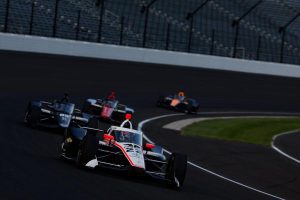IndyCar is in a battle against the clock with its hybrid-assist device that is scheduled to be on every car when the NTT IndyCar Series season opens March 10.
IndyCar, along with its engine manufacturers Chevrolet and Honda, have been testing the hybrid-assist unit for the past three months. It began with one Honda team and one Chevrolet team testing at Sebring (Fla.) Int’l Raceway and Alabama’s Barber Motorsports Park.
It increased to two Chevrolet teams and two Honda operations Oct. 12-13 at Indianapolis Motor Speedway.
In early December, that will increase to a 10-car test as engineers and manufacturers try to remedy heat and reliability issues that have plagued the system.

Time is running short, but IndyCar is determined to introduce the hybrid-assist device to competition in a few months.
Matt Niles, a senior engineer and large project leader for Honda, is spearheading the manufacturer’s hybrid effort.
“We’re pretty set on where we are with the energy storage,” Niles told SPEED SPORT. “I think we’ve been finding out how all these different components survive in this environment. The vibration is unique. Also, the temperatures that we deal with. We’ve been learning a lot about that.
“But I think going forward, a lot of it is really how we use the system and the parts and pieces we have, and how that’s regulated on track and how the drivers use it, how the engineers interface with it, how we go racing. That’s where we’ve been going through sort of a street course at the short course at Sebring, we’ve been running short ovals, road courses and now we’re here at this hallowed ground (Indianapolis) to see how it works here.
“We just kind of have to go back through all the data, start making some decisions on how we go to St. Pete.
“I think to get to where all the teams have their hands on it, our goal is to have that before the end of the year,” Niles continued. “I think getting all the parts and pieces in place by St. Petersburg is going to be a challenge. But that’s what we do here, is challenges. So we’re going to keep pushing ahead and get it done.”
Rob Buckner is the IndyCar program manager for Chevrolet. His engineering staff has been pouring over the data to make sure the hybrid-assist lives up to expectations.
“It’s similar for us; a massive learning curve every time we go testing,” Buckner told SPEED SPORT. “It’s a new knob in terms of race cars are giant energy balance equations. This is another new factor in that. We found it could change car balance.
“The drivers have been enjoying having a different experience in the car beyond what a 2.2-liter engine package has always been engine-wise. We’ll keep learning and go from there.”
The hybrid-assist unit stores kinetic energy and releases it with an added boost of horsepower. There will indeed be more horsepower, but the added weight of the unit along with the weight of the aeroscreen may prohibit an increase in speed.
During the October test at Indianapolis Motor Speedway, there were four teams including Chevrolet drivers Power at Team Penske and Alexander Rossi and David Malukas sharing the wheel for Arrow McLaren.
Honda was represented by Colton Herta and Marcus Ericsson sharing the ride for Andretti Global. Two-time NTT IndyCar Series champion Alex Palou drove both days for Chip Ganassi Racing.
“We’re still trying to get more power, squeeze more than we can out of that every year,” Niles explained. “It’s a new piece, a new bit of energy. So even though we kind of all have the same system, there are some differences in how you might use it, how a driver might interface with it. Our engineers are able to sort of dig into that and try to figure out the best way to go forward.
“As far as the collaboration, normally we’re out here, it’s cutthroat, which we love competing out here. We’ve been able to wave the white flag and get this done, which has been really good. It’s been a great collaboration.”
